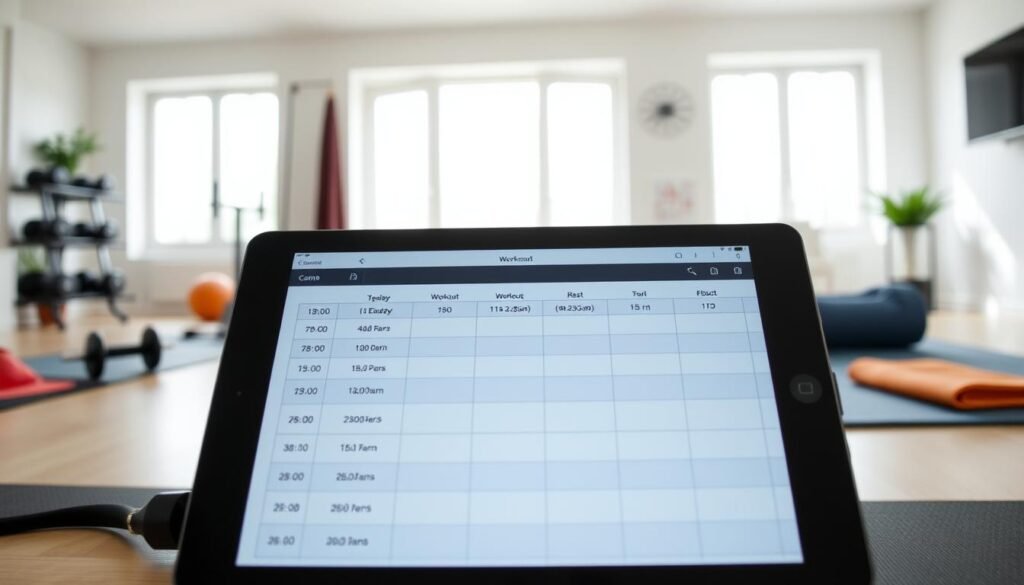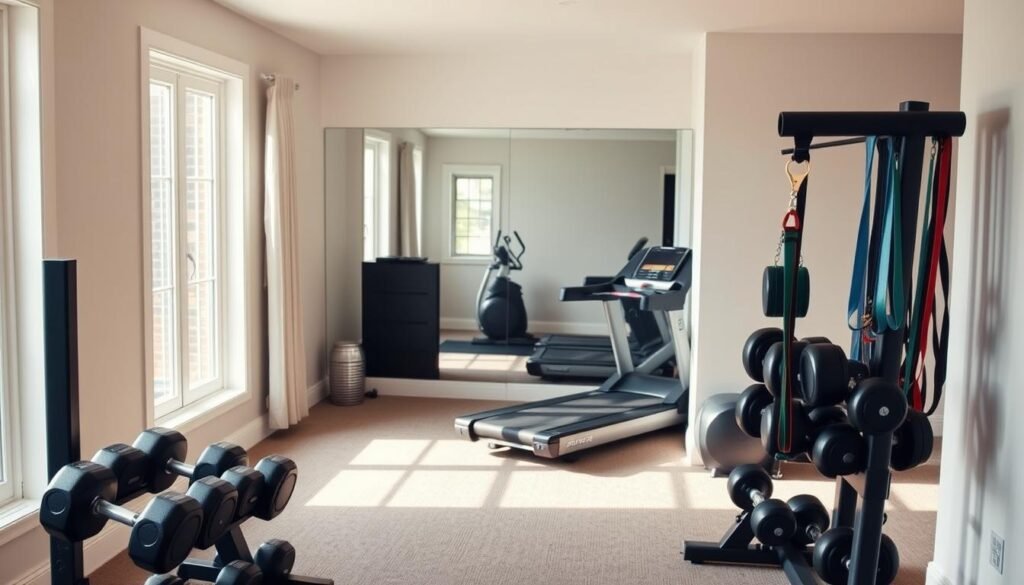Starting a workout plan is easy. But sticking to it? That’s where most people struggle. Life gets busy, motivation fades, and suddenly that gym membership collects dust. Sound familiar? You’re not alone – research shows over 50% of exercisers quit within six months.
The secret isn’t willpower. It’s strategy. This guide offers 12 practical methods used by athletes and trainers. No vague advice – just clear steps to build habits that last.
You’ll learn how to create accountability, design flexible schedules, and bounce back from setbacks. We’ll even tackle the real reason most plans fail (spoiler: it’s not laziness).
Key Takeaways
- Common roadblocks that derail exercise routines
- Why traditional motivation tricks often backfire
- How to turn workouts into non-negotiable habits
- Tools for tracking progress without obsession
- The mindset shift that prevents burnout
Establish Clear and Realistic Fitness Goals
Setting vague goals like “get fit” or “exercise more” often leads to quitting. Without a clear plan, motivation quickly disappears. That’s why fitness goal consistency begins with setting goals that are challenging yet achievable.
Define Your Short-Term and Long-Term Goals
Short-term goals are stepping stones, while long-term goals keep you focused. For instance:
- 30-day goal: “Lose 2lbs weekly by walking 10,000 steps daily”
- 6-month goal: “Run a 5K race in under 30 minutes”
Reaching short-term goals boosts confidence, while long-term goals prevent burnout. A study showed that setting both types of goals increases workout adherence by 76%.
Use the SMART Criteria for Goal-Setting
The SMART framework turns dreams into doable plans. Here’s how it works:
| SMART Element | Vague Goal | SMART Goal |
|---|---|---|
| Specific | “Exercise more” | “Do 3 strength sessions weekly” |
| Measurable | “Get stronger” | “Increase deadlift by 20lbs in 8 weeks” |
| Achievable | “Lose 20lbs in a month” | “Lose 4-6lbs monthly through diet changes” |
| Relevant | “Train for a marathon” (if you hate running) | “Master 5 yoga poses to improve flexibility” |
| Time-Bound | “Build muscle someday” | “Gain 5lbs of muscle by December 1st” |
This method removes the guesswork in developing a routine for fitness success. It turns daily actions into measurable results. Track your progress weekly and adjust your goals if needed. Flexible plans are more likely to succeed than rigid ones.
Create a Structured Workout Schedule
Consistency comes from having a plan. Create a workout calendar that fits your daily rhythm. This way, you won’t have to guess when to work out. It helps you stay focused, even when life gets busy.

Determine Your Availability and Preferences
First, take a look at your week. Use a calendar to mark:
- Things you can’t change (work hours, family time)
- When you have the most energy (morning or evening workouts)
- How long you like to work out (30 minutes or an hour)
The American College of Sports Medicine says you need 150 minutes of moderate exercise each week. You can do this in different ways. For example, three 50-minute sessions or five 30-minute workouts are both good.
“Exercise programming should align with individual capabilities and time constraints to promote adherence.”
ACSM Position Stand on Physical Activity Guidelines
Mix Different Types of Workouts
Changing up your workouts keeps things interesting. Try mixing these:
| Workout Type | Weekly Target | Examples |
|---|---|---|
| Cardio | 3-5 sessions | Running, cycling, dance workouts |
| Strength | 2-3 sessions | Weightlifting, resistance bands, bodyweight exercises |
| Flexibility | 2-4 sessions | Yoga, dynamic stretching, mobility drills |
Match tough workout days with easy ones. For example, do heavy strength training then gentle yoga. Apps like Nike Training Club have pre-built hybrid programs that mix different types of workouts for you.
Track Your Progress Regularly
Staying on track with fitness goals is more than just effort. It’s about seeing your progress. Tracking your journey keeps you accountable and shows patterns you might miss. Whether you like digital tools or writing things down, being consistent is crucial for success.
Use Fitness Apps or Journals
Digital tools like MyFitnessPal and Apple Health make tracking easy. They give you real-time info on calories, steps, and heart rate. These apps work with wearables, showing trends over time. But, don’t overlook old-school methods like a journal. It lets you write down feelings, energy, and small victories that apps might not catch.
| Method | Pros | Cons |
|---|---|---|
| Fitness Apps | Automated tracking, data visualization, reminders | Overload of data, battery dependency |
| Journals | Personalized notes, emotional reflection, no tech needed | Manual entry, less precise metrics |
Celebrate Small Milestones Along the Way
A good way to stay motivated is to celebrate small wins. Here’s a simple plan:
- Weekly Wins: Treat yourself to a movie night or new workout gear after 3+ sessions.
- Monthly Check-Ins: Compare progress photos or measurements. Reward yourself with a massage or your favorite meal.
- Quarterly Rewards: Plan a weekend getaway or take premium fitness classes after 12 weeks of sticking to it.
Seeing small improvements in stamina or flexibility boosts your motivation. Celebrating your progress helps keep you on track.
Find a Workout Buddy or Support Group
Working out with someone else makes it easier to stay on track. Studies show that exercising with a buddy can boost your commitment by 76%. Having someone to share the journey with keeps you motivated and focused.
Benefits of Accountability in Fitness
Exercising with others adds a layer of accountability that’s hard to ignore. Here’s why it’s effective:
- Reduced procrastination: Knowing someone is counting on you makes it harder to skip workouts.
- Friendly competition: A bit of competition can encourage you to push yourself harder.
- Emotional support: Having someone to support you makes tough days easier to handle.
“Group exercise participants report higher satisfaction and longer-term commitment compared to solo trainees.”
Journal of Social Sciences (2023)
How to Choose the Right Partner
Finding the right workout buddy is key. Use this table to see if you’re a good match:
| Factor | Why It Matters | Ideal Match |
|---|---|---|
| Schedule Alignment | Consistent workout times prevent cancellations | Someone with similar availability |
| Fitness Intensity | Mismatched effort levels cause frustration | Partner matching your current ability |
| Personality Type | Encouragement style affects motivation | Supportive but challenging demeanor |
Choose someone who celebrates your wins and supports you through tough times. If you prefer virtual support, apps like Strava or MyFitnessPal offer communities to share progress and advice.
Build a Reward System
Staying consistent with fitness goals often comes down to one thing: making progress feel worth the effort. A well-designed reward system turns abstract achievements into tangible victories. This keeps you engaged even when workouts get tough. Let’s break down how to create incentives that align with your goals without derailing your progress.
Set Up a Reward Structure for Consistency
Tiered rewards work best because they match your growing commitment. Try this approach:
- 3-day streak: Treat yourself to a massage or relaxing activity
- 7-day streak: Buy new workout socks or accessories
- 30-day streak: Invest in premium gear like shoes or resistance bands
This structure creates multiple opportunities to celebrate while working toward bigger milestones. Apps like Habitica or Streaks can help track your daily wins automatically.
Choose Rewards That Motivate You
Effective rewards should excite you without conflicting with your fitness objectives. Consider these options:
- Fitness-related purchases (hydration bottles, gym bags)
- Experience-based treats (movie nights, weekend hikes)
- Skill-building rewards (yoga workshop tickets)
Avoid rewards that undo progress, like cheat meals high in sugar or skipping workouts. Instead, focus on incentives that reinforce healthy habits. For example, a new playlist for cardio days or a scenic running route discovery keeps the journey fresh.
Stay Flexible with Your Routine
What if your fitness plan could bend without breaking? You don’t have to stick to a strict routine that makes you tired. Being flexible lets you adjust to life’s changes while still making progress.
Adjust Your Schedule as Needed
Life can be unpredictable—deadlines change, kids get sick, or you might not have the energy. Instead of missing workouts, try the 80/20 rule. Aim for 80% consistency and 20% flexibility. For example, if you’re short on time, swap a gym session for a brisk walk.
“Recovery days are essential for muscle repair and preventing overtraining.”
NCCIH Research

Incorporate Rest Days Without Guilt
Rest isn’t laziness—it’s smart. Studies show that active recovery, like yoga or light stretching, improves performance and lowers injury risk. Here’s how to make rest work for you:
- Schedule 1-2 rest days weekly
- Try foam rolling or mobility exercises
- Prioritize sleep for muscle recovery
Need help staying on track? Check out how to stay consistent with working out even when life gets busy. Remember, progress isn’t always straight, but being adaptable keeps you moving forward.
Focus on Nutrition and Hydration
Your fitness journey isn’t just about reps and sets—it’s fueled by what you eat and drink. Proper nutrition and hydration are key for energy, recovery, and progress. Without them, even the most disciplined workout routine can fall short.
Understanding the Role of Diet in Fitness
Food isn’t just calories—it’s information for your body. The USDA’s Dietary Guidelines for Americans say to balance proteins, carbs, and fats. This supports muscle repair and energy levels.
For example, eating complex carbs with lean protein after a workout helps. It replenishes glycogen stores and repairs tissue.
“Think of your meals as part of your training plan. What you eat directly impacts how quickly you recover and how strong you feel tomorrow.”
– Registered Sports Nutritionist
To maximize results, aim for:
- Pre-workout fuel: Light snacks like bananas or oatmeal 30–60 minutes before exercise
- Post-workout recovery: Meals with a 3:1 carb-to-protein ratio within 2 hours
- Daily consistency: Regular meals aligned with your activity level
For deeper insights, explore how consistency in fitness and nutrition creates lasting results.
Staying Hydrated for Optimal Performance
Water makes up 60% of your body—and even mild dehydration can zap strength and focus. Use this simple formula: Your weight (lbs) ÷ 2 = minimum daily ounces. A 150-pound person needs at least 75 oz daily, plus extra for sweat loss.
| Activity Level | Additional Water Needed | Electrolyte Source |
|---|---|---|
| Low (yoga, walking) | 8–16 oz | Coconut water |
| Moderate (weight training) | 16–24 oz | Bananas + nuts |
| High (HIIT, endurance) | 24–32 oz | Sports drink or electrolyte tablets |
Electrolytes like sodium and potassium become crucial during intense sessions. Signs you need them include muscle cramps, headaches, or fatigue lasting hours post-workout. For most workouts under 90 minutes, water and whole foods suffice—save sports drinks for marathon efforts.
Keep Your Workout Space Motivating
Your environment is key to sticking to your fitness routine. A messy or dull space can suck the energy out of you. But a well-thought-out area can boost your motivation. Let’s explore how to make a workout zone that keeps you eager to exercise every day.

Organize a Dedicated Workout Area
Choose a specific spot in your home for working out, even if it’s just a corner. Studies reveal that having a dedicated space can make you 76% more likely to stick to your routine. Here are five tips to make your workout area effective:
| Principle | Benefit | Example |
|---|---|---|
| Mirror Placement | Improves form awareness | IKEA HOVNÄS full-length mirror |
| Equipment Accessibility | Reduces setup time | Sunny Health & Fitness foldable treadmill |
| Ventilation | Enhances stamina | Lasko oscillating fan |
| Lighting | Boosts energy levels | Philips Hue smart bulbs |
| Motivation Boards | Strengthens commitment | Dry-erase goal tracker |
Use Inspiring Decor and Equipment
Surround yourself with things that bring joy and motivation. Affordable brands like Sunny Health & Fitness offer stylish dumbbells and resistance bands. Here are some ideas:
- Hang framed fitness quotes at eye level
- Add vibrant yoga mats or kettlebell sets
- Use color psychology—red for energy, blue for focus
Creating a routine for fitness success begins with a space you want to use. Change your decor with the seasons or add plants like snake plants. Your workout area should feel like a personal retreat, not a burden.
Overcome Mental Barriers to Consistency
Your biggest challenge to staying consistent might not be physical. It’s often in your mind. Self-doubt, boredom, or a need for perfection can stop you before you even start. Knowing these mental hurdles is the first step to creating lasting fitness habits.
Identify Common Psychological Hurdles
Four mental traps often get in the way of fitness goals:
- All-or-nothing thinking: “If I can’t do a full hour, why bother?”
- Comparison burnout: Measuring yourself against social media fitness stars
- Fear of failure: Avoiding workouts to dodge imperfect results
- Delayed gratification: Struggling to stay motivated without instant changes
Strategies for Staying Motivated
Here are some science-backed ways to beat mental resistance:
- Cognitive reframing: Change “I have to exercise” to “I get to strengthen my body”
- The 5-Minute Rule: Start with just five minutes of activity—you might end up doing more
- Progress stacking: Mix workouts with fun activities (like listening to podcasts while walking)
For more tips, check out these proven strategies to stay motivated when your brain says “not today.” Remember, it’s not about never missing a day. It’s about getting back on track faster than before.
Educate Yourself on Fitness Topics
To keep your fitness journey alive, learning is as important as lifting weights. Good information helps you stay away from false trends and maintaining motivation for fitness goals. Let’s look at how to gain knowledge that supports lasting progress.

Read Books and Articles on Fitness
Begin with science-backed sources like the American College of Sports Medicine’s (ACSM) guidelines. Books like Atomic Habits by James Clear mix behavior science with fitness tips. For articles, choose peer-reviewed journals or sites like Healthline and ACE Fitness.
| Resource Type | Example | Credibility Check | Key Benefit |
|---|---|---|---|
| Books | ACSM’s Guidelines for Exercise Testing | Look for PhD authors | Comprehensive science |
| Articles | NIH-funded studies | Check .gov or .edu domains | Latest research |
| Influencers | NASM-certified coaches | Verify certifications | Practical tips |
Follow Reputable Fitness Influencers or Coaches
Social media can be a treasure trove if you follow NASM or ACE-certified pros. Stay away from influencers pushing “quick fixes” or untested supplements. Look for those who:
- Share free educational content
- Cite peer-reviewed studies
- Encourage sustainable habits
For example, Coach Kara Corey (MS, RD) debunks nutrition myths, and Jeff Nippard’s YouTube channel explains workout science. Always check claims with trusted sources like the National Academy of Sports Medicine.
Incorporate Technology for Support
Your smartphone is more than just for scrolling. It’s a powerful tool to help you stay on track with workouts. From heart rate monitors to apps with virtual trainers, technology makes it easier to follow through. Let’s look at how to use these tools to stay consistent.
Utilize Fitness Trackers and Apps
Apps like FitOn and Strongr Fastr make workouts personal. FitOn offers free classes with famous trainers. Strongr Fastr combines strength training with AI meal planning. Here are some top wearable devices:
| Device | Key Features | Best For |
|---|---|---|
| Whoop 4.0 | Recovery metrics, sleep analysis | Advanced athletes |
| Garmin Venu 3 | GPS tracking, hydration alerts | Outdoor enthusiasts |
| Fitbit Charge 6 | Heart rate zones, YouTube workouts | Budget-conscious users |
These tools remind you to move when you’ve been still too long. A Whoop user said:
“Seeing my strain score each morning makes me compete against myself to hit new records.”
Explore Online Classes and Communities
Apps like Peloton and Apple Fitness+ offer live classes. You get cheered on by instructors. Apps like Strava create friendly competition, turning solo runs into team efforts. Here are three ways virtual communities help:
- Real-time progress comparisons with peers
- Badge systems for completing weekly challenges
- 24/7 chat support for motivation slumps
Reddit’s r/xxfitness community (850k+ members) shows the power of digital support. Members share workout selfies, like “Didn’t want to lift today, but remembered you’re all watching!”
Reflect and Reassess Your Fitness Journey
Regular reflection keeps your fitness routine on track. It’s not just about numbers. It’s about knowing what works and where you need to change. Quarterly check-ins help you stay true to your goals and celebrate your progress.
When to Evaluate Your Goals
Check your goals every three months. Use tools like body scans, strength tests, or endurance benchmarks. Apps like MyFitnessPal or Fitbit show your workout, nutrition, and recovery patterns.
If progress slows, it’s time to rethink your approach. Don’t give up on your goals.
Make Necessary Adjustments for Growth
Break through plateaus by adjusting the FITT principles. Increase resistance if you’re not getting stronger. Try different exercises like cycling instead of running.
Shorten rest times or add 10 minutes to your workouts. Small changes can make a big difference.
Tracking your fitness journey gets easier with data and intuition. Listen to your body’s signs. Stay committed to growth, and you’ll see lasting results.

